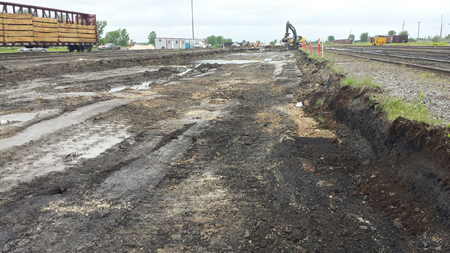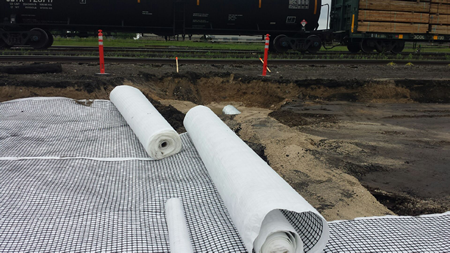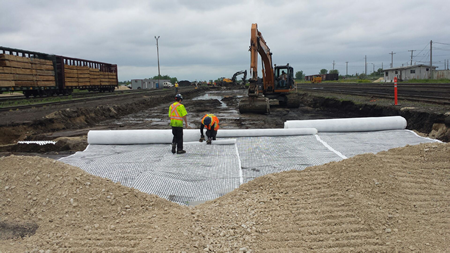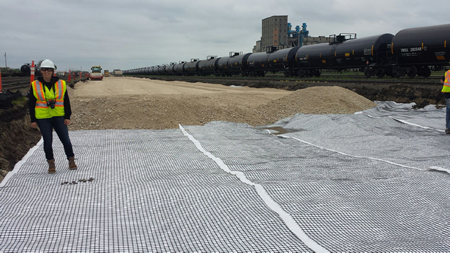
By Sam Bhat – The Canadian National Railway (CN Rail) wanted to build an additional 6-track extension at the Transcona yard in Winnipeg, Manitoba. Heavy rail cars were expected to pass over this extension area, but the site was not situated on ideal soils for further railway development. CN Rail discovered quickly that the track extension project would need to be delayed while it returned to the engineering community in search of a more economical, environmentally friendly, and technically sound solution.
Building Railways over Swamp
The Transcona site was characterized by swampy conditions. In some sections, the wet and soft clay soils were so poor that a person attempting to walk it would sink 6 or more inches. The subgrade soils simply had very low shear strength in their saturated state.

A soil-only capping layer was not possible, as it would need to be much too thick for economical and timely construction. Furthermore, persistent rainfall worsened the situation, and the project managers were keenly aware that to attempt track construction over such a soft and plastic subgrade could lead to progressive shear failure and excessive plastic deformation.
The risks of escalating short-term costs, the need for a more complicated long-term maintenance plan, and frequent route disruption (i.e., reduced railway efficiency) compelled the track owner to shelve the project while options were re-evaluated.
Rejecting the Conventional Approach
The conventional solutions for constructing railways on this sort of weak subgrade, particularly for heavy rail usage, have involved soft soil stabilization techniques, such as excavation and replacement, lime or lime cement stabilization, preloading, vertical drains, sand or sand-lime piles, stone columns, and similar solutions—some of which would have required the construction of working platforms to transfer equipment between stages.
Each of these options was deemed too cumbersome, timely, or expensive for the location.
A geosynthetic solution was proposed.

Based on the nature of the subgrade soils and the type of loading, a geosynthetic system would need to provide three functions: soil separation, filtration, and reinforcement. A robust, biaxial geogrid composite (TE-BXC30) was recommended by Titan Environmental Containment. What made this solution unique is that it provided a single-layer approach to accomplishing all three functions. The TE-BX30PP biaxial geogrids featured a 6oz, continuous filament, needle-punched nonwoven geotextile bonded to the geogrid. As such, a reinforcement system could be provided in an efficient, easy-to-install, rolled product.
The new design allowed the composite reinforcement to be placed directly over the weak and saturated subgrade along with a 600mm thick granular (< 50 mm limestone) capping/sub-ballast, which was compacted above the geosynthetic.
Multi-Functional Reinforcement
The apertures of a geogrid interlock with the granular material resulting in a mechanical interaction that creates a strong platform having significantly strong lateral and flexural stiffness.
The higher stiffness in the geogrid was essential in Winnipeg, to account for higher tensile modulus and efficiency in confining and strengthening the fill particles. Heavy railway applications require a greater absorbing of elastic deflections than highway applications. Because of this, the TE-BXC30 composite geogrid was specified. It offered the robustness needed for the application.

Also, for the extremely weak soils at the Winnipeg site, the geogrid composite layer provided more benefit than just long-term track performance. It essentially acted within the first fill lift as a working platform and facilitated speedy construction of the rest of the railway track system. The nonwoven component of the composite acted as a separator, which prevented loss of granular material into the soft subgrade during placement and compaction of the fill. This confinement enabled the soil capping layer to be compacted to a high density.
The separation strength also prevented fines from migrating due to the pumping action that the system would be subjected to from repeated, heavy, dynamic loads of passing rail cars.
Furthermore, the filtration characteristics of the geotextile prevented the build-up of excess pore pressure in the subgrade.
Overall, the geosynthetic design distributed the tensile forces evenly and widely through the granular subgrade while providing a high degree of lateral restraint. The previously weak subgrade now resisted deformation and failure.
The work was executed successfully and efficiently and met all the railway operator’s goals for cost management, construction timeframe, environmental suitability, and system dependability and performance.
Composite Reinforcement Solutions
| BENEFITS |
| Reduced maintenance |
| Significant saving in fill thicknesses |
| Minimized differential settlement |
| Reduced rate of permanent settlement |
| Eliminated excavation and replacement with imported fill |
| Reduced elastic deflections with heavy rail car traffic while allowing consistent high speeds to be achieved |
The utilization of Titan’s TE-BXC30 biaxial geogrid composite in Winnipeg exemplifies a newer approach to reinforcement design: composite geosynthetic reinforcements in a single layer. Manufacturing advances have made this possible. Not too many years ago, a design like this would have required multiple, individual layers of geosynthetics and aggregates.
It’s a strong example of how the geosynthetics field has consistently produced more economical constructions while providing greater strength, efficiency, and utility in infrastructure.
The composite product specified for CN Railway’s work is a TE-BX30PP biaxial geogrid that is heat-bonded to a 6oz needle-punched nonwoven.
The biaxial geogrid is made of virgin polypropylene and punch-and-drawn in the manufacturing process. This process makes it bi-directionally oriented, monolithic, and isotropic—all part of achieving the exceptional redistribution of forces within the subgrade. The grid features integral nodes, high tensile and flexural stiffness, high torsional rigidity, and strong junction efficiency.
It’s a solution that is ideal for combined soil stabilization/reinforcement applications with enhanced separation and filtration needs.
PROJECT DETAILS
Project: Railway track extension: CN Rail Transcona Yard
Location: Winnipeg, MB Canada
Installation: Summer 2014
Product Solution/System: TE-BXC30 biaxial geogrid composite
Owner: CN Rail
Design Engineer: Aecom
General Contractor: Raymond Vauclair Projects Ltd.
Product Supplier: Titan Environmental Containment Ltd, Manitoba, Canada
*(Supplied the products and offered technical/installation guidance)
Sam Bhat, M.Eng, is the Vice President of Global Business Development and CTO Geosynthetics for Titan Environmental Containment Ltd , www.titanenviro.ca. Sam can be reached at : sam@titanenviro.ca, cell +1 416 399 6613.












How would this solution help reduce the large deflections encountered due to the clay soils with freeze/thaw conditions? The soil under the 600mm of fill will surely rise and fall every summer and winter cycle.
Hi C Thorpe,
Thanks for your question. It is true that the sub-grade is weak saturated and clayey. However there is a flexurally geogrid reinforced stiff platform over the weak sub-grade. The load is distributed widely and evenly over the entire reinforced area, thus greatly reducing the pressure over the sub-grade and would minimize the differential settlement and the reduce the rate of permanent settlement. The geogrid composite at the interface of sub-grade/ sub-base separates the two soils and prevents the upward movement of the fines by pumping action. Further due to the higher tensile modulus/ stiffness of the geogrid, the elastic deflections induced by the dynamic rail car loading will be greatly absorbed. We have not seen any adverse outcome with freeze/ thaw conditions using geogrid reinforcement. However monitoring the site after summer and winter cycle can be certainly considered to generate some valuable data.